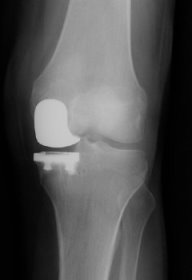The knee joint involves the patella, the lower end of the femur and the upper tibia, all are enclosed within the same sleeve of synovial membrane and supported by the surrounding ligaments and muscles. Functionally there are three separate compartments: the patellofemoral joint between the deep surface of the patella and the front of the femur; the medial compartment between the medial femoral condyle and the medial tibial plateau on the inner aspect of the knee; and the lateral compartment between the lateral femoral condyle and the lateral tibial plateau on the outer aspect of the knee.
Osteoarthritis can affect one, two or all three of these joint compartments to a greater or lesser degree. As a result of this we can choose to replace just the affected part of the joint in about 50% of cases of osteoarthritis rather than the whole joint. The big advantage of this is that it in a smaller operation than a total knee replacement, with less blood loss and a shorter stay in hospital. It also results in a more normal feel to the knee and better overall function.
Partial replacements of just one compartment are called unicompartmental knee replacements; two compartments - bicompartmental knee replacements and three compartments - total knee replacements.
Resurfacing rather than replacement
The procedure of unicompartmental or bicompartmental knee replacement is more of a resurfacing procedure rather then a replacement although the word replacement is still most commonly used. In effect a relatively thin layer of bone and cartilage is removed no thicker than 9 mm in most cases from the affected surfaces and replaced with a metal, or ceramic on metal surface with a plastic or high density polyethylene bearing. It is important to realise that during a UKR there is always the potential for the surgeon to have to switch to a total knee replacement for technical reasons if the knee is just not suitable for a partial knee procedure. Your surgeon will discuss this with you during consultation. Generally speaking partial knee replacements are not suitable for patients with inflammatory conditions arthritis such as Rheumatoid Arthritis.
Medial UKR
The commonest compartment to replace alone is the medial one. This is treated by a medial UKR by which we mean medial unicondylar or unicompartmental knee replacement.
|

|
|
X-ray of a medial UKR
|
ANIMATION
Lateral UKR
Similarly in lateral UKR the lateral compartment of the knee is replaced that is lateral unicondylar or unicompartmental knee replacement. The number of patients needing a lateral unicompartmental knee replacement is relatively much smaller than those with medial compartmental disease.
Patellofemoral replacements
Patellofemoral replacements are given a separate section on this website under 'Treatments' as the operation is rather different from medial or lateral UKR.
Results
Most partial knee replacements achieve an excellent result although it is often longer before your surgeon will allow full-weight bearing on a UKR. Nevertheless the period in hospital is shorted because there is less surgical trauma and less blood loss. Longer term there is always a risk that the other joint compartments within your knee will also be affected by osteoarthritis. As a result the reported outcomes of partial knee replacements are not quite as good as for total knee replacement.
If the other compartments do deteriorate they can be replaced individually or the joint converted from a partial knee replacement to a total knee replacement at a later date. This is not usually much more difficult than a primary total knee replacement.
For more information on partial knee replacements please see this leaflet - Partial Knee Replacements
TEXT Copyright London Knee Clinic® 2014